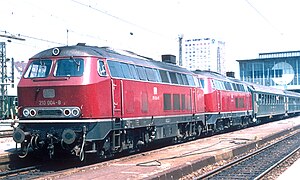DB Class 210

Two DB 210 locomotives at Munich station (1973)
|
|||||||||||||||||||
|
|||||||||||||||||||
|
|||||||||||||||||||
|
|||||||||||||||||||
| Type and origin | |
|---|---|
| Power type | Diesel internal combustion engine, plus gas turbine booster engine |
| Builder | Krupp |
| Serial number | 210 001-008 |
| Build date | ~1970 |
| Total produced | 8 |
| Rebuild date | 1980–1981 |
| Number rebuilt | 8 |
| Specifications | |
|---|---|
| UIC class | B'B' |
| Gauge | 1,435 mm (4 ft 8 1⁄2 in) |
| Length | 16.4 m (53 ft 9.7 in) |
| Loco weight | 82 t (81 long tons; 90 short tons) |
| Prime mover | Main engine :MTU 12V 956 TB 10 Turbine: AVCO Lycoming T53-L 13 |
| Engine type | Main engine : diesel engine Secondary: Gas turbine |
| Transmission | hydraulic |
| Loco brake | hydrodynamic |
| Performance figures | |
|---|---|
| Maximum speed | 160 km/h (99 mph) |
| Power output | 1,839 kW or 2,466 hp main diesel plus 845 kW or 1,133 hp turbine |
| Tractive effort | Starting 235 kN (53,000 lbf) |
The Class 210 of the Deutsche Bundesbahn (DB) consisted, briefly, of a series of eight diesel locomotives, with a top speed of 160 km/h intended for operations on express trains. The locomotives were peculiar in that an additional gas turbine engine was able to provide extra power when needed. The additional turbine made it, at the time, the strongest four axle German diesel locomotive.
Derived from a prototype, classified as DB Class V 169 (later named Class 219), the locomotives had a ten-year service life, from ~1970 to ~1980, at which point they were rebuilt as a subclass of the conventional DB Class 218.
Another set of locomotives the Class 210.4 also had the '210' number, being rebuilt from DB Class 218s in the late 1990s for faster (160 km/h) express passenger operations.
In the 1950s the Swiss Federal gas turbine locomotive, the Am 4/6 1101 was tested by the German railways: Its higher fuel consumption compared to the DB Class V 200.0 made it uneconomical for the Deutsche Bundesbahn to consider introducing similar locomotives and afterwards reciprocating diesel engines were the primary source of non-electric traction on German raillines.
In the 1960s, the first locomotives of the V160 series went into service; these were originally designed for medium-duty service. For more demanding applications such as express passenger work and freight trains on non-electrified routes (such as the winding route from Munich to Lindau) the Deutsche Bundesbahn considered an enhanced performance version of these locomotives; for this reason, the concept of a locomotive of V160 series with a gas turbine as a booster was investigated. The gas turbine had the advantage of low weight and size - particularly important if it was to be included in the standard body of a V160 class locomotive.
Because the turbine would only be activated when additional power was required (such as accelerating from speeds above 25 km/h and on inclines) the effect of the high fuel consumption of the turbine would be minimised. The output from the turbine was to be input on an additional stage on the hydraulic transmission. This concept was successfully tested in the DB V 169 001 locomotive built in 1965 (as of 1968, the reporting name was 219 001).
However, the Deutsche Bahn decided that the successor to this locomotive should have a more powerful gas turbine and the AVCO Lycoming T 53-L13 was selected which had already been selected for use in the Bundeswehr Helicopter Bell UH-1 D. The Klöckner-Humboldt-Deutz factory (see Deutz AG Motorenfabrik Oberursel (now part of Rolls-Royce Germany) made the engines for the German Army under license, and was able to maintain and repair the turbines.
...
Wikipedia
